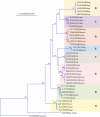Zoonotic potential and molecular epidemiology of Giardia species and giardiasis
- PMID: 21233509
- PMCID: PMC3021202
- DOI: 10.1128/CMR.00033-10
Zoonotic potential and molecular epidemiology of Giardia species and giardiasis
Abstract
Molecular diagnostic tools have been used recently in assessing the taxonomy, zoonotic potential, and transmission of Giardia species and giardiasis in humans and animals. The results of these studies have firmly established giardiasis as a zoonotic disease, although host adaptation at the genotype and subtype levels has reduced the likelihood of zoonotic transmission. These studies have also identified variations in the distribution of Giardia duodenalis genotypes among geographic areas and between domestic and wild ruminants and differences in clinical manifestations and outbreak potentials of assemblages A and B. Nevertheless, our efforts in characterizing the molecular epidemiology of giardiasis and the roles of various animals in the transmission of human giardiasis are compromised by the lack of case-control and longitudinal cohort studies and the sampling and testing of humans and animals living in the same community, the frequent occurrence of infections with mixed genotypes and subtypes, and the apparent heterozygosity at some genetic loci for some G. duodenalis genotypes. With the increased usage of multilocus genotyping tools, the development of next-generation subtyping tools, the integration of molecular analysis in epidemiological studies, and an improved understanding of the population genetics of G. duodenalis in humans and animals, we should soon have a better appreciation of the molecular epidemiology of giardiasis, the disease burden of zoonotic transmission, the taxonomy status and virulences of various G. duodenalis genotypes, and the ecology of environmental contamination.
Figures


References
-
- Abe, N., I. Kimata, and M. Iseki. 2003. Identification of genotypes of Giardia intestinalis isolates from dogs in Japan by direct sequencing of the PCR amplified glutamate dehydrogenase gene. J. Vet. Med. Sci. 65:29-33. - PubMed
-
- Abe, N., I. Kimata, and M. Tokoro. 2005. Genotyping of Giardia isolates from humans in Japan using the small subunit ribosomal RNA and glutamate dehydrogenase gene sequences. Jpn. J. Infect. Dis. 58:57-58. - PubMed
-
- Abe, N., C. Read, R. C. Thompson, and M. Iseki. 2005. Zoonotic genotype of Giardia intestinalis detected in a ferret. J. Parasitol. 91:179-182. - PubMed
-
- Abe, N., T. Tanoue, E. Noguchi, G. Ohta, and H. Sakai. 2010. Molecular characterization of Giardia duodenalis isolates from domestic ferrets. Parasitol. Res. 106:733-736. - PubMed
-
- Abou-Shady, O., M. S. El Raziky, M. M. Zaki, and R. K. Mohamed. Impact of Giardia lamblia on growth, serum levels of zinc, copper, and iron in Egyptian children. Biol. Trace Elem. Res., in press. - PubMed
Publication types
MeSH terms
LinkOut - more resources
Full Text Sources
Medical

